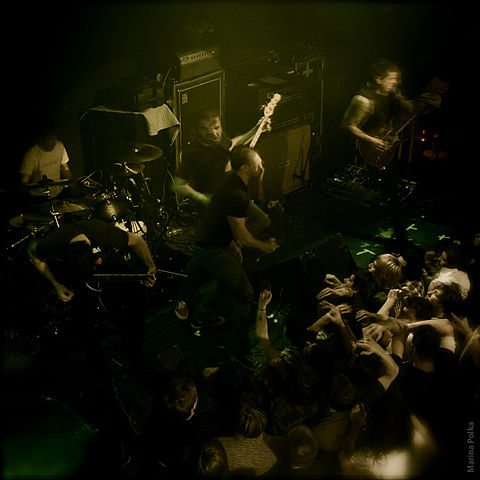A couple of years back I had the distinct pleasure of watching the Dillinger Escape Plan as they headlined the “Summer Slaughter Tour”. Even in Denver’s cavernous Ogden Theater, Dillinger still managed to make the show as intimate as a small club gig would be.
Fast forward one album cycle, and a heartbreaking announcement of the band’s impending dissolvement, and they are as much of a volatile force to be reckoned with as ever.
The Dillinger Escape Plan uncompromisingly harnesses the sound of controlled chaos. Any listener can attest to their seemingly flawless ability to sound like an explosion, while still keeping the song in time. Their live show is of no deviance from this trend.
I was fortunate enough to witness possibly the band’s last stop in Colorado, this past week at Denver’s beloved Marquis Theater. The bill exhibited a diverse spread of bands. This made the show tolerable, as it didn’t feel like I was being assaulted with heavy music for the full 4 hours. As much as I love loud music, having two bands that played variations of indie rock in the opening roster broke up the show, and left room for the energy to detonate when Dillinger took the stage.
The night started off with Bent Knee, a Boston art rock band. They exhibited dark, symphonic tones and odd time signatures to augment their already full 6-member sound.
Following Bent Knee, was Salt Lake City’s metallic Gods,Cult Leader, the only heavy band of the three openers. Cult Leader mowed through every song on their short 30-minute set, and didn’t waste time taking breaks.
Atlanta’s O’brother capped out the opening bands. O’brother reminded me of a louder,darker, Pink Floyd during their release of “The Wall”. They made use of their diverse cast of three guitarists throughout the whole set to create a sonically textural tone.
At last, Dillinger took the stage. The room’s energy ignited like dousing a fire with gasoline. As Billy Rymer began the opening fill to “Limerent Death”, the place blew up. Frontman Greg Puciato’s shrill vocals screeched over the PA, and chaos ensued.
For the majority of the show the crowd was assaulted with a barrage of strobe lights that seemed to amp up the energy in the room above what it had previously been. Such booming visuals reflected the aggressive sound of the band’s albums.
Dillinger’s setlist spanned almost every release, and even included slower songs such as “One of Us Is The Killer” and “Mouth of Ghosts”. Their first four songs spanned two decades of their discography from their most recent release,“Dissociation”, to 2004’s “Miss Machine” and 2010’s “Option Paralysis”, among others.
Shows like this remind me of the void that will be left in metal once Dillinger breaks up. There is a sound that only they can create. Their ability to infuse elements of jazz, metal, and electronic music all with obscured time signatures left me hooked when I heard them years ago. Being able to see them one last time was a reminder of the lasting impact they’ve had on how I think about music, and how truly cathartic the chaos of their shows can be.

